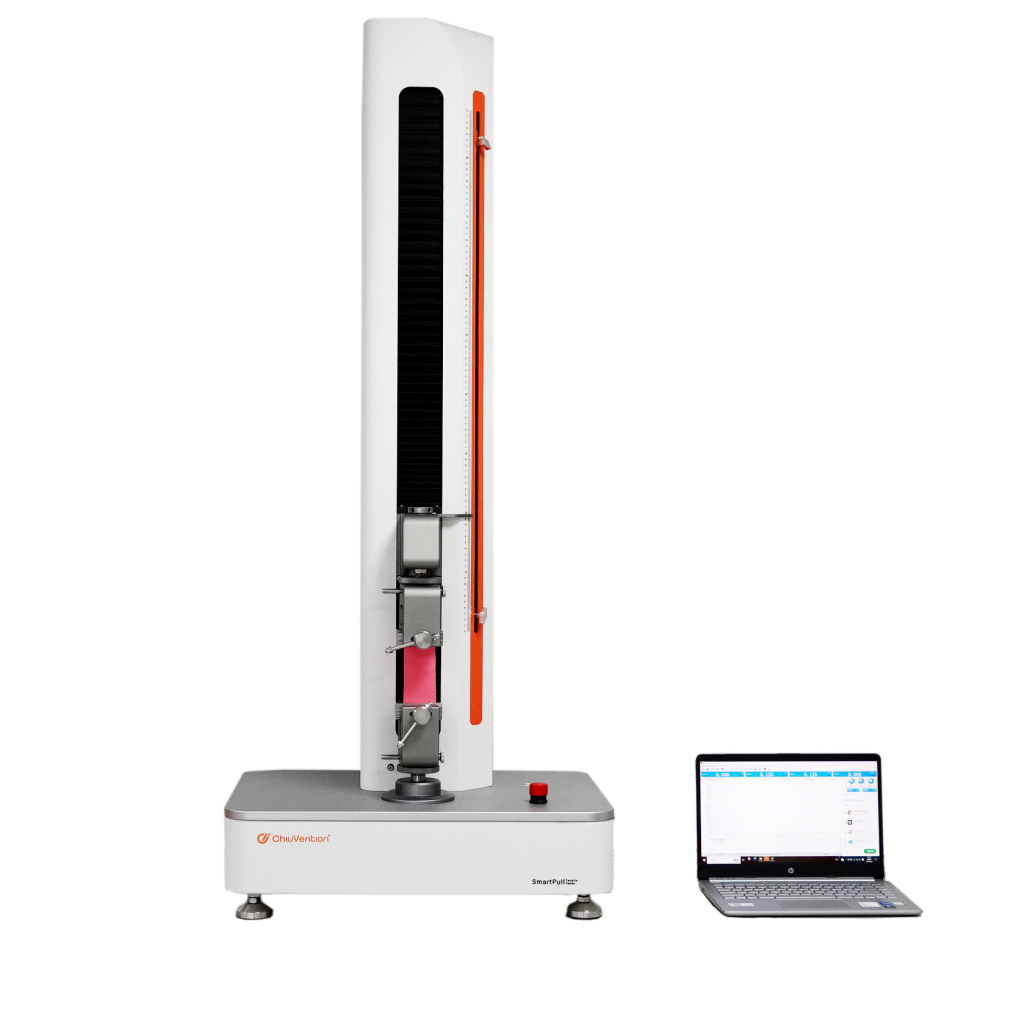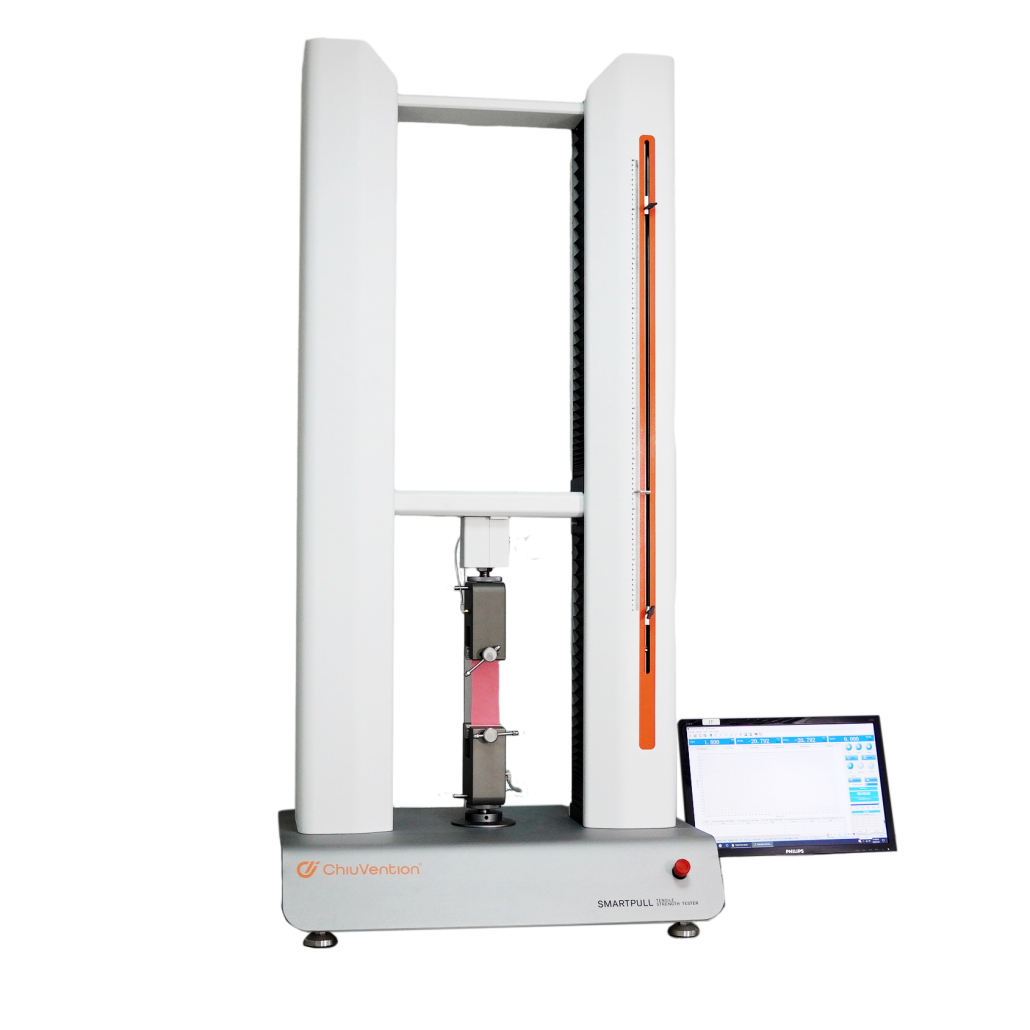Introduction to Tensile Elasticity and Strength Testing
The tensile elasticity of woven fabrics is a crucial property that impacts the performance, durability, and overall quality of textiles. The FZ/T 01034 test method specifies how to determine this property using a Constant Rate of Elongation (CRE) tester. Unlike knitted fabrics, which use a different approach, woven fabrics are tested with a cyclic stretching method, making this test essential for evaluating fabric resilience and elastic recovery. This article will explore the testing procedures, required equipment, and various factors influencing the accuracy of test results, including the use of fabric tensile strength testers and tensile strength equipment.
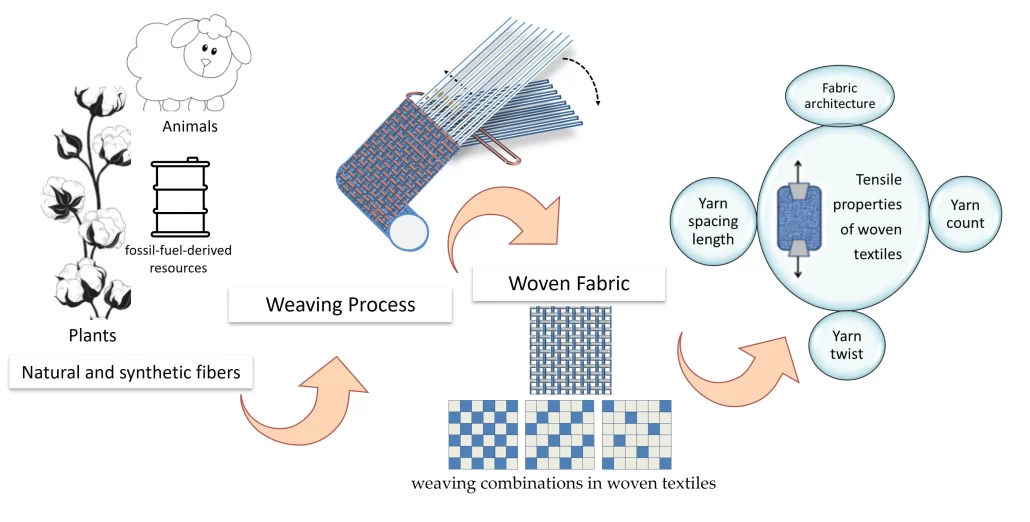
Tensile Elastic Properties of Woven Fabrics: Understanding Fabric Strength
Woven fabrics undergo deformation when stretched under a fixed elongation or fixed force. After a specified period, the stretching force is removed, and the fabric is allowed to recover for a set time. The residual elongation is then measured. The elastic recovery rate and plastic deformation rate are calculated to characterize the tensile elasticity of the fabric, helping to assess the fabric’s tensile strength and durability.
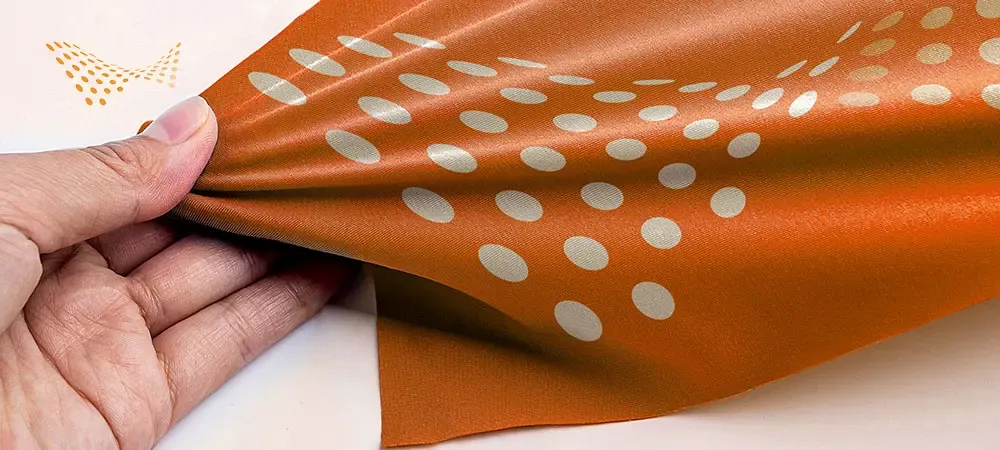
Essential Requirements for Tensile Strength Testing Instruments
Constant Rate of Elongation (CRE) Tester
The CRE tester must meet the GB/T 3923.1 standard with a force accuracy of ±1%. It should be capable of performing tests such as fixed elongation and fixed force, and it should have a data recording device. Using Tensile Strength Equipment, such as a Universal Tensile Testing Machine, enhances test accuracy by offering precise force measurements and enabling detailed data analysis.
Stretching Clamps
Manual or pneumatic clamps with a clamping surface of at least 55 mm are required, with the effective width of the sample being 50 mm.
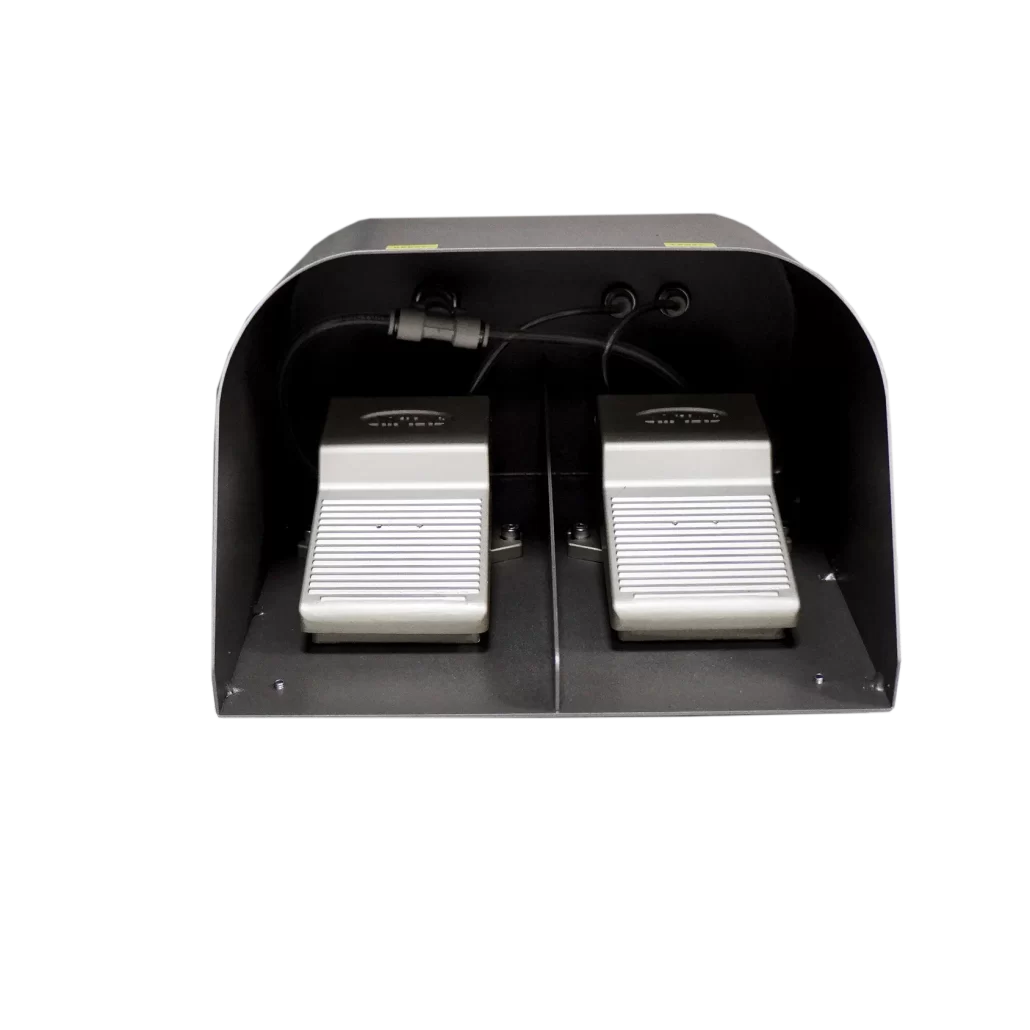
Tools for Cutting Samples
Scissors or specialized samplers are necessary for cutting the fabric samples.
Pre-tension Weights
Pre-tension weights should be used according to test specifications. It can be manually applied or set in the software.
Sampling Techniques for Tensile Elasticity and Strength Testing
The sample should be representative, ensuring that no obvious wrinkles or defects affect the fabric tensile strength testing results.
The cutting of samples should be carried out in accordance with GB/T 3923.1. Samples should be cut at a distance of 10 cm from the edge of the fabric sample, and each sample should not contain the same yarns.
Sample size and quantity: At least three samples in the warp and weft directions should be cut from each sample. The length of the sample should meet the gauge length of 200 mm, and the width should meet the effective width of 50 mm.
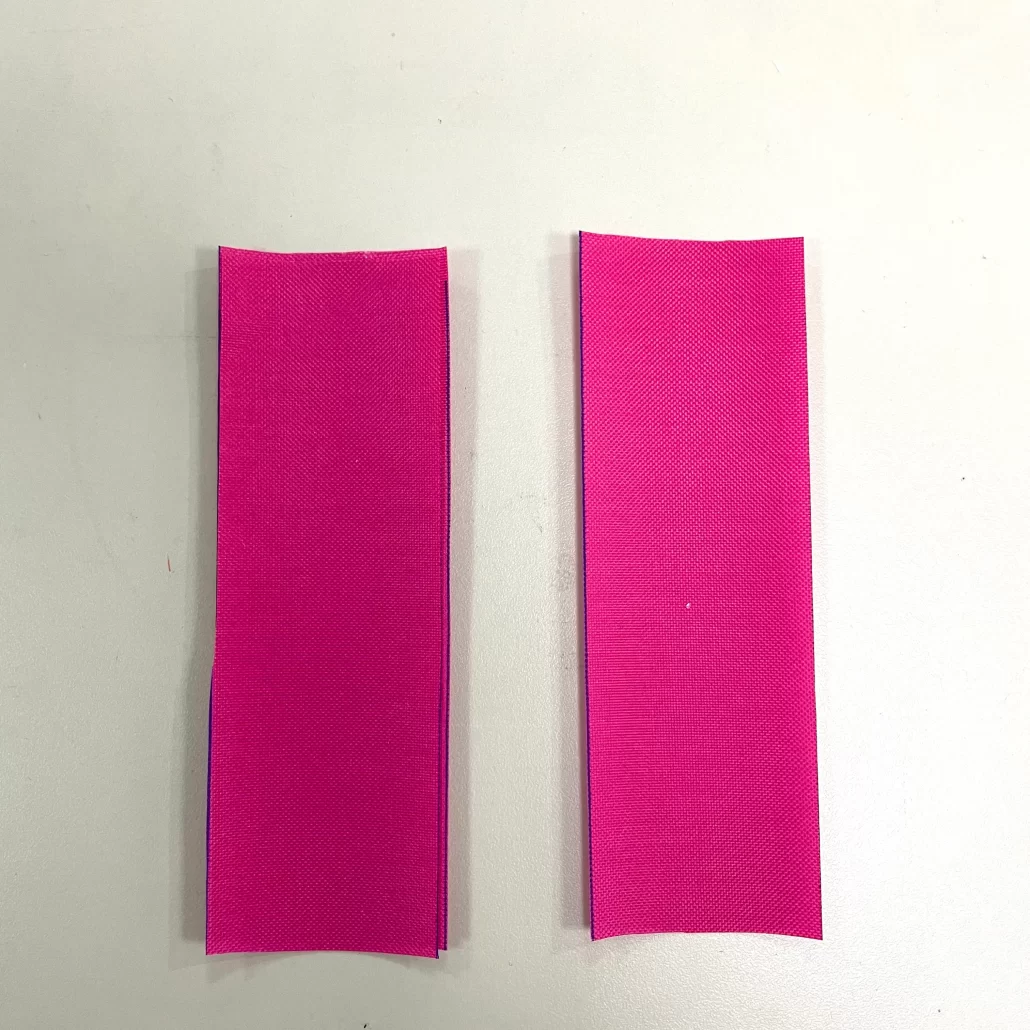
Test Conditions for Accurate Tensile Strength and Elasticity Measurement
- The pre-conditioning and conditioning of samples should be carried out in accordance with GB 6529.
- The test should be carried out in the standard atmosphere of the second-class temperate zone specified in GB 6529.
- Set the gauge length of the strength tester to 200 mm.
- Stretching speed for fixed elongation test:
When the elongation rate is <8%, the stretching speed is 20 mm/min; when the elongation rate is >8%, the stretching speed is 100 mm/min. - Stretching speed for fixed force test:
According to the preliminary test, when the elongation rate at the specified force is <8%, the stretching speed is 20 mm/min; when the elongation rate is >8%, the stretching speed is 100 mm/min. - Pre-tension clamping:
The sample should be clamped in the middle position of the clamp to ensure that the center line of the pulling force passes through the center of the clamp. The sample can be clamped with the pre-tension in Table 1. If the elongation rate generated is greater than 2%, the pre-tension value should be reduced. - Loose clamping:
When the loose clamping method is used for the sample, the initial length required for calculating the elongation rate should be the sum of the gauge length and the elongation of the sample when the pre-tension is reached.
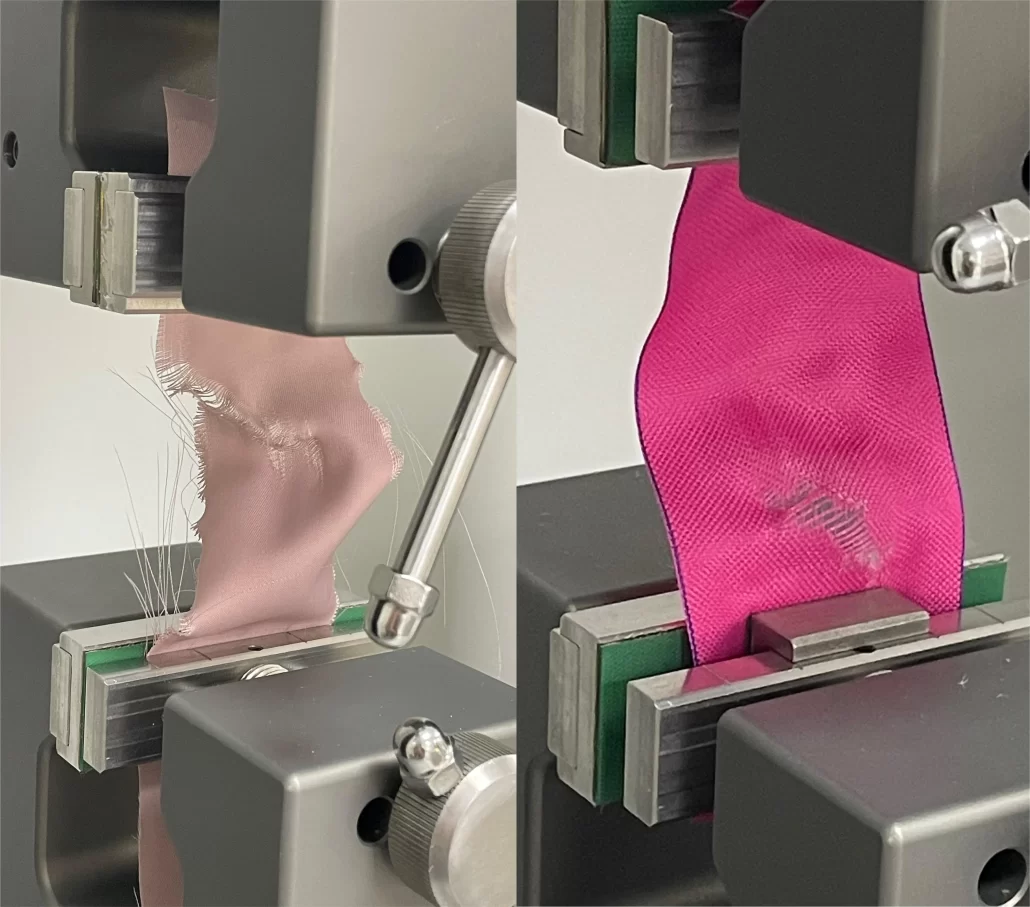
Test Procedure for Tensile Elasticity and Strength Evaluation
Fixed Force Elongation Test
- For this test, the sample is stretched to a fixed force, typically 20N, 25N, or 30N, and the elongation is measured to calculate the fabric tensile strength. The tensile strength tester will provide the tensile strength in fabric by determining the force required to cause elongation.
- Start the instrument and stretch the sample to the fixed force. Read the length L1 of the sample.
- Calculate the fixed force elongation rate (%) of each sample according to Equation (1). The test result is expressed as the average value of three samples and rounded to 0.1%.

Fixed Elongation Force Determination
- Determine the fixed elongation according to the product requirements or the agreement between both parties. If there is no agreement, 3%, 5% or 10% is recommended.
- Start the instrument (when the sample is loosely clamped, start counting the elongation from when the pre-tension is reached), stretch the sample to the fixed elongation value, and read the corresponding force in Newton (N).
- The test result is expressed as the average value of three samples and rounded to 0.1N.
Determination of Fixed Force Elastic Recovery Rate and Plastic Deformation Rate
- Select the fixed force value according to the product requirements or the agreement between both parties. If there is no agreement, 20N, 25N or 30N is recommended.
- The stretching holding time and recovery time are determined according to the agreement between both parties. If there is no agreement, a stretching holding time of 1 min and a recovery time of 3 min are recommended.
- Start the instrument, stretch the sample to the fixed force, and hold the fixed force for 1 min. Then read the length L1 of the sample. Then return the clamp to the zero position at the same speed and stop for 3 min.
- Stretch the sample to the specified pre-tension at the same speed again and read the length L2 of the sample.
- Calculate the elastic recovery rate and plastic deformation rate (%) of each sample according to Equation (2) and Equation (3). The test result is expressed as the average value of three samples and rounded to 0.1%.
Once the fixed force is applied, the elastic recovery rate and plastic deformation rate are calculated, which are key indicators of tensile strength in fabric.
Repeated Tensile Elastic Recovery Rate and Plastic Deformation Measurement
- Select the fixed cycle number according to the product requirements. If there is no agreement, 3 times, 5 times or 10 times are recommended.
- Repeat the stretching according to 3.1 – 3.3 until the predetermined cycle number is reached, and measure the length L1.
- Measure the length L2 according to the method in 3.4.
- Calculate the fixed force repeated tensile elastic recovery rate and plastic deformation rate of each sample according to Equation (2) and Equation (3). The test result is expressed as the average value of three samples and rounded to 0.1%.
Elastic Recovery Rate in Fixed Elongation Testing and Plastic Deformation
- Select the fixed elongation according to the product requirements or the agreement between both parties. If there is no agreement, 3%, 5% or 10% is recommended.
- The stretching holding time and recovery time are determined according to the product requirements or the agreement between both parties. If there is no agreement, a stretching holding time of 1 min and a recovery time of 3 min are recommended.
- Start the instrument (when the sample is loosely clamped, start counting the elongation from when the pre-tension is reached), stretch the sample to the fixed elongation L3, stop for 1 min. Then return the clamp to the zero position at the same speed and stop for 3 min.
- Stretch the sample to the fixed elongation L3 again at the same speed.
- Read the length L2 of the sample corresponding to the pre-tension in 2.1.
- Calculate the fixed elongation elastic recovery rate and plastic deformation rate (%) of each sample according to Equation (4) and Equation (5). The test result is expressed as the average value of three samples and rounded to 0.1%.
Repeated Tensile Elastic Recovery and Plastic Deformation in Fixed Elongation Testing
- Select the fixed cycle number according to the product requirements or the agreement between both parties. If there is no agreement, 3 times, 5 times or 10 times are recommended.
- Repeat the stretching according to 5.1 – 5.3 until the predetermined cycle number is reached.
- Stretch the sample to the fixed elongation L3 according to 5.4.
- Read the length L2 of the sample corresponding to the pre-tension.
- Calculate the fixed elongation repeated tensile elastic recovery rate and plastic deformation rate of each sample according to Equation (4) and Equation (5). The test result is expressed as the average value of three samples and rounded to 0.1%.
Stress Relaxation Rate Measurement in Fixed Elongation Testing
- Select the fixed elongation according to the product requirements or the agreement between both parties. If there is no agreement, 3%, 5% or 10% is recommended.
- Start the instrument (when the sample is loosely clamped), and record the force F0 when the sample reaches the fixed elongation. Then return the clamp to the zero position at the same speed.
- Calculate the stress relaxation rate (%) of each sample according to Equation (6). The test result is expressed as the average value of three samples and rounded to 0.1%.
Determination of Fixed Elongation Repeated Tensile Stress Relaxation Rate
- Select the fixed elongation according to the product requirements or the agreement between both parties. If there is no agreement, 3%, 5% or 10% is recommended.
- Select the fixed cycle number. If there is no agreement, 3 times, 5 times or 10 times are recommended.
- Start the instrument (when the sample is loosely clamped), record the force F0 when the sample reaches the fixed elongation for the first time, and then return the clamp to the zero position. Repeat the stretching until the selected cycle number is reached. Then stop for 10 min and record the force F1, accurate to 0.1N.
- Calculate the repeated fixed elongation stress relaxation rate of each sample according to Equation (6). The test result is expressed as the average value of three samples and rounded to 0.1%.
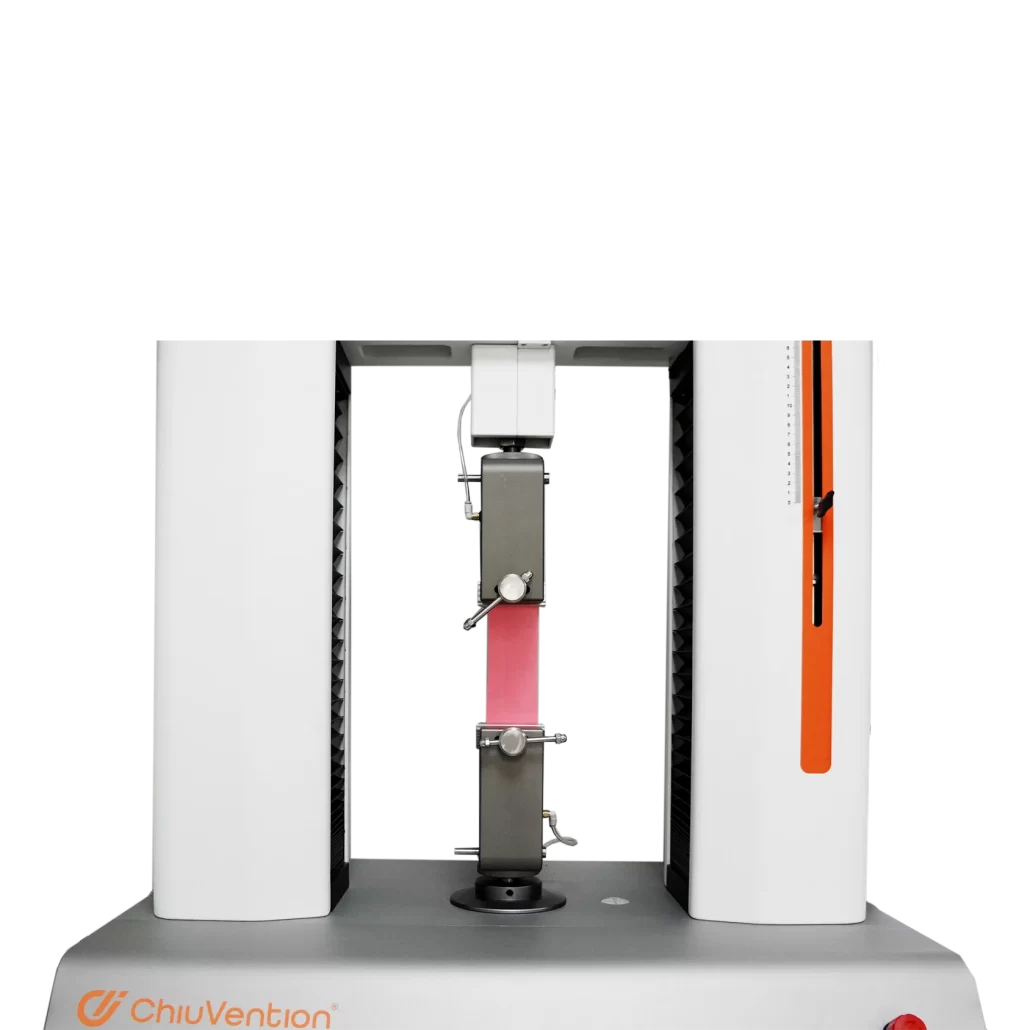
Summary on FZ/T 01034 Test Method of Tensile Strength Testing
This standard specifies the following 8 test methods:
- Fixed force elongation test
- Determination of fixed force elastic recovery rate and plastic deformation rate
- Determination of fixed force repeated tensile elastic recovery rate and plastic deformation rate
- Fixed elongation elastic recovery rate and plastic deformation rate determination
- Fixed elongation repeated tensile elastic recovery rate and plastic deformation rate determination
- Fixed elongation stress relaxation rate determination
- Fixed elongation repeated tensile stress relaxation rate determination
This standard specifies eight test methods, including fixed force elongation tests, elastic recovery, and stress relaxation rate determination. These tests evaluate key aspects of fabric durability, comfort, and overall tensile strength. The tests help manufacturers assess how fabrics will perform under various stress conditions.
Elastic recovery rate
- Essential for assessing the long-term durability of fabrics and their ability to return to their original shape after stretching.For example, elastic fibers (such as spandex) have a high elastic recovery rate, which can make the garment return to its original shape after wearing and reduce wrinkles.
- During knitting or weaving, a good elastic recovery rate helps maintain the shape and dimensional stability of the textile.
Plastic deformation rate
- Determines the ability of a fabric to maintain its shape after repeated use. A high plastic deformation rate means that the textile may undergo irreversible deformation after repeated use or washing.
- When designing and selecting materials, the plastic deformation rate needs to be considered to ensure that the textile can maintain its shape and function in actual use.
Stress relaxation rate
- Important for functional textiles that need to retain their tensile strength and elasticity over time. For example, if the stress relaxation rate of the elastic part of a garment is high, it may cause the garment to lose its original elasticity over time.
- In functional textiles (such as sportswear, medical textiles, etc.), the stress relaxation rate is a key indicator because these textiles need to maintain their performance for a long time.
Key Factors Affecting Tensile Strength and Elasticity Test Results
Eccentricity of the Force Measuring Mechanism
The electronic fabric tensile strength tester measures force during the tensile test, and any misalignment in its components can lead to measurement errors. Even slight eccentricity in the Tensile Strength Equipment can introduce radial forces, affecting the tensile strength tester’s readings and causing discrepancies in the tensile strength in fabric measurements.
The force measuring mechanism of an electronic strength tester typically includes a sensor, direction joint or connecting rod, and upper and lower clamps. Within this mechanical system, there can be concentricity issues between the sensor, direction joint or connecting rod, and the clamps. During the tensile test, the alignment of these components can shift, causing deviations in the center lines of the force measuring system and the sample. This leads to the pulling force applied by the sensor being transferred as an axial component to the sample. Although the elongation of textile materials is often considerable, small deviations in alignment typically result in minimal errors in force measurement. However, eccentricity can generate a radial force on the sensor’s strain body, causing bending and deformation of the sensor, which in turn alters the output and results in measurement errors. It’s important to consider the design, manufacturing, and installation accuracy of the force measuring mechanism to minimize eccentricity errors. To avoid accidental damage that could cause eccentricity errors, sensor and clamp installation and removal should be minimized during daily testing.

Effect of Clamping Force on Tensile Strength Testing Accuracy
The clamping force must be properly controlled during testing. Insufficient clamping may cause the fabric to slip, while excessive clamping can lead to fiber breakage, reducing the fabric tensile strength and affecting test accuracy.
This slipping can be easily detected during the test and can be avoided. However, excessive clamping force is more problematic, as it is harder to detect and can significantly affect the test results. Research shows that errors from excessive clamping can exceed 10%, and in some cases, can be as high as 20%, far beyond the acceptable limits for textile testing. When the clamps grip the sample too tightly, shearing forces occur at the clamp jaws, which can break or partially break the fibers at that point, reducing the sample’s tensile strength and introducing measurement errors. The degree of fiber breakage depends on the clamping force, so careful control of this force is essential to minimize errors. Most test methods do not specify exact clamping forces, as the thickness and structure of the fabric samples vary. This variability means that the operator’s experience and adaptability can influence test accuracy. The best approach is to apply just enough clamping force to prevent slipping during the test.
Influence of Pre-Tension on Tensile Strength Testing Results
Factors Affecting Elongation Measurement in Electronic Strength Testing
The principle behind an electronic strength tester is that sample elongation corresponds to the displacement of the clamp, with elongation measured by the length change in the sample due to the applied pulling force. However, factors such as the textile’s flexibility, sample weight, clamp mechanics, and operator skill can result in the sample being clamped at a length longer than the set gauge length. In the initial stretching phase, the clamp’s displacement may not yet stress the sample but merely straighten it. When the sample begins to be stressed, the displacement already recorded by the clamp is mistakenly counted as part of the sample’s elongation, leading to measurement errors. In reality, the total elongation includes both the displacement due to straightening and the actual elongation of the fabric under stress. This results in an overestimation of the sample’s elongation.
The Role of Pre-Tension in Minimizing Measurement Errors
To minimize errors caused by sample loading, pre-tension is often applied. Pre-tension refers to the slight tension applied to the sample before it undergoes the main stretching process. This ensures that the sample does not stretch prematurely, and the elongation caused by the pre-tension itself is minimal and can be ignored in most cases.
Pre-tension values can vary by testing method. For instance, ASTM D5034-1995 recommends a fixed pre-tension of 1.67N, while ISO 13934-1:1999 provides three different pre-tension values based on the unit area weight of the fabric: 2N, 5N, and 10N. The latter approach is generally considered more accurate for minimizing errors.
In practical application, applying pre-tension can be challenging. One common method involves fixing the upper end of the sample, then attaching a clip or weight equal to the pre-tension value at the lower end. However, the mechanical design of most strength testers prevents this method from being fully effective, as it’s difficult to apply pre-tension at the lower end of the sample. Instead, some operators manually apply pre-tension by pulling the sample by hand. While this method may reduce errors somewhat, it lacks consistency, as the force applied can vary across samples. This inconsistency makes the method less suitable for accurate data collection and analysis.
Pre-Tension Control Methods and Their Impact on Elongation Accuracy
To improve consistency, some electronic strength testers are equipped with pre-tension control software. This allows the user to input the desired pre-tension value into the test parameters. At the start of the test, the crossbeam moves slowly until the pre-tension is reached. Once the pre-tension is achieved, the sample begins to stretch at the set test speed, and elongation is only recorded after the pre-tension threshold is met. This approach minimizes the errors introduced by improper sample loading.
Typically, the pre-tension specified in most test methods is minimal, and for standard textile and clothing materials, the elongation caused by pre-tension is negligible compared to the elongation induced by tensile strength. However, for samples with a very small initial modulus—those that elongate significantly under a small force—the elongation due to pre-tension can be more pronounced. This elongation is not recorded during the test, leading to an underestimation of the total elongation. As a result, further investigation is needed to better understand the effects of pre-tension on such samples.
In summary, while pre-tension is designed to minimize errors, the method’s effectiveness varies depending on sample characteristics, and further research is required to optimize pre-tension values for specific fabric types.
Summary on Tensile Elasticity and Strength Testing
Several factors can influence the accuracy of results in tensile testing, including the eccentricity of the force measuring mechanism, clamping force, and pre-tension. Addressing these issues through careful equipment design, accurate test procedures, and appropriate sample handling is crucial to obtaining reliable and repeatable results.
Conclusion
The FZ/T 01034 test method for tensile elasticity of woven fabrics provides detailed procedures for accurately determining the fabric’s tensile strength and elastic recovery. By adhering to the recommended procedures and using reliable fabric tensile strength testers and tensile strength equipment, manufacturers and researchers can ensure precise, repeatable results. Furthermore, understanding and mitigating factors such as clamping force, eccentricity, and pre-tension are essential for obtaining accurate readings and enhancing the durability and performance of textile materials.
ChiuVention focuses on smart textile testing instruments. For more information about laboratory testers or to obtain professional testing solutions, please contact us!
Email: sales@chivention.com
WhatsApp: +86 180 2511 4082
Linkedin: Chiuvention
